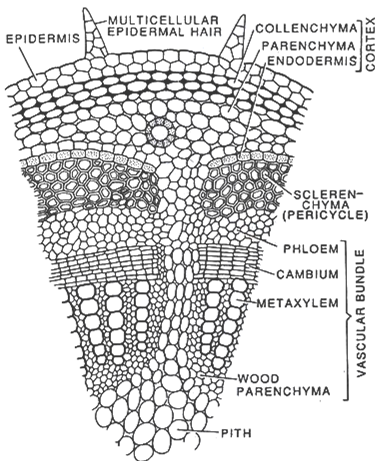 Short Answer Type
Short Answer TypeGive scientific terms for each of the following
The formation of blood cells in the bone marrow.
State the best known contribution of:
(i) Nawaschin (ii) John Otto
(iii) Went (iv) T.R. Malthu
(a) Draw a neat and fully labeled diagram of a T.S of dicotyledonous stem.
(b) List three differences between micronutrients and macronutrients of plants.
(c) Describe the significance of osmosis in plants.
(a) 
(b)
| Microelements | Macroelements |
| The concentration of a microelement is less than 1 mg/gm of dry matter | The concentration of a macroelement per gram of dry matter is at least 1 mg or 100 mg. |
| These are required in less amount | These are required in more amount. |
| For eg - Carbon, hydrogen, nitrogen and oxygen. | For eg. Zinc boron, etc. |
(c) Osmosis is the diffusion of water molecules through a semi permeable membrane from the region of low solute concentration to the region of high solute concentration. Osmosis in itself is responsible for several processess in the plants. The growth of plant is directly or indirectly related to the process of osmosis from the soil. Osmosis is responsible for transpiration, guttation, ascent of sap etc.
In plants osmosis is at least partially responsible for the absorption of soil water by root hairs and for the elevation of the liquid to the leaves of the plant.
 Long Answer Type
Long Answer Type(a) Describe the cohesion and transpiration pull theory of ascent of sap.
(b) Explain the sequence of events between pollination and fertilisation in plants.
(c) State and explain Blackman’s Law of Limiting Factors.
(a) Write two functions each of:
(i) Amniotic fluid (ii) Human placenta
(b) Briefly explain the procedure followed for haemodialysis.
(c) Explain the origin and conduction of heart beat in man.
a) What is reflex action? Draw neat labeled diagram of reflex arc.
(b) Mention a cause and symptom of each:
(i) Osteoporosis (ii) Constipation.
(iii) Asthma (iv) Tetany
(c) Write four functions of the human skeletal system.
(a) Explain the effects of gibberellins on plants.
(b) Describe the mechanism of pulmonary gaseous exchange.
(c) Mention the site of secretion and function of the following hormones:
(i) Choleystokinin (ii) Oxytocin
(iii) Insulin
(a) Describe the procedure of hybirdisation in plants.
(b) Name the causative agent and the main preventive measure for each of the following diseases:
(i) Amoebiasis
(ii) Rabies
(iii) Pneumonia
(c) What is manure? Explain any two types of manures.
(a) State three differences between Homologous and Analogous organs and give an example of each.
(b) Explain the resistance of mosquitoes to pesticides such as DDT
(c) What is the importance of preservation the germplasm of wild species?
